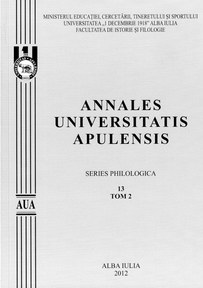Strategii traductive cu implicaţia glosării. Aplicaţie pe textul „Bibliei” de la Blaj
Translation Strategies Implying glossing.Application on the text of „Bible” in Blaj
Author(s): Ana Veronica Catană-SpenchiuSubject(s): Language and Literature Studies
Published by: Universitatea »1 Decembrie 1918« Alba Iulia
Keywords: notes; translation; Bible; translation technics; Bible translation; Samuil Micu
Summary/Abstract: The Romanian Bible tradition2presets an important number of meta-textual elemnets. Glosses, introductions, footnotes or marginal notes represented the best way for translators and revisers to motivate in an explicit way their translation options and to present their translation strategies. In many cases a translation that presented marginal notes or / and footnotes was resulted from the translator’s need of overcoming a literal translation and, in the same time, a way of introducing his voice and way of thinking in order to be heard. The first translation of the Bible into Romanian language, The “Biblie” from Bucharest (1688) dominated the Romanian speaking area for 107 years, until next century when Samuil Micu’s translation, the “Bible” from Blaj appeared in 1795. This biblical translion is well-known today by the name - the Bible form Blaj (1795) - and not by the name of scholar who translated it, the Greco-catholic Samuil Micu. This translation had as source the text of the Septuagint, a protestant edition from Franeker, Holland, made by a known scholar, Lambert Bos, in 1709 and not Vulgata the representative text of the Catholic Church. Althoough the the Bible from Blaj (1795) is a new translation, after the Old Greek-text mentioned above, Samuil Micu had revised, in the same time, the text of the Bible from Bucharest (1688), the only complete translation available in that period. Although the translation from Blaj (1795) was accomplished by a Greco-catholic Romanian scholar, his text will be used almost in every subsequent Romanian translation and in some cases revision. This was the case of the edition that appeared at Sankt Petersburg in 1819, the edition made by the bishop Filotei from Buzău in 1854-1856, the edition from Sibiu made by Andrei Şaguna and the modern edition from 1914. The literal translation made by Samuil Micu is caracterised by an important number of 1631 of glosses, consisting in explinations of words, expressions. In this way the Romanian translator could inform the possible readers about some unknown realities and costums but, in the same time, could offer a second translation of a line. The first part of this paper is a description of the gloss translation and the second part deals with a classification of this notes. We chose as criteria for the classification: the content and the references to other important Bible translations. Many of the glosses present different comments and in the analysis we used for a productive comparison the two source-texts: the Septuagint from Franeker (1709) for the Bible from Blaj (1795) and the edition from Frankfurt (1597) for the Bucharest Bible (1688), Vulgata Clementina, the edition from 1929, Vulgata from Blaj 1760-1761 and the two partial translations: Ms 45 and Ms. 4389.
Journal: Annales Universitatis Apulensis. Series Philologica
- Issue Year: 13/2012
- Issue No: 4
- Page Range: 253-276
- Page Count: 25
- Language: Romanian

